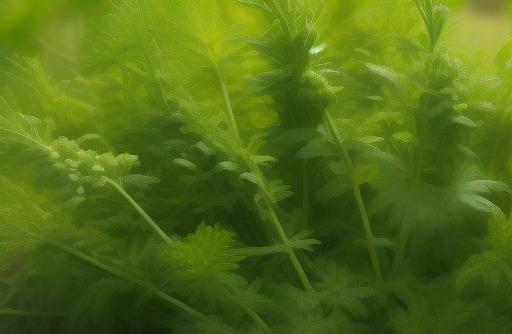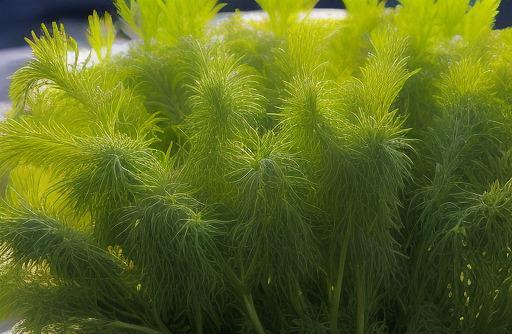- You are here:
- Home »
- Food Substitutes
- » Best Substitutes For Dill
Best Substitutes For Dill

Dill is a unique herb with a distinct flavor that adds a refreshing and tangy taste to dishes. It is commonly used in cuisines around the world, adding a hint of freshness to salads, soups, pickles, and sauces. However, there may be instances when you run out of dill in your pantry or are unable to find it in your local grocery store. In such cases, it becomes necessary to find a suitable substitute that can mimic the flavor and aroma of dill. This guide will explore various alternatives to dill and provide tips on how to use them effectively in your cooking.
Key Takeaways
- Dill is an herb with a unique flavor that adds freshness to dishes.
- Substitutes for dill can be used when you run out of the herb or cannot find it.
- Some popular alternatives to dill include fennel, tarragon, cilantro, and parsley.
- Each substitute has its own distinct flavor profile, so choose the one that complements your dish best.
- Adjust the quantity of the substitute based on your personal preference and the desired intensity of flavor.
Why You Need A Substitute For Dill
There are various reasons why you may need to find a substitute for dill. Firstly, fresh herbs can sometimes be difficult to find, especially if you live in a region where dill is not commonly used. Additionally, dill has a relatively short shelf life and may spoil quickly, leaving you without this essential ingredient. Finally, budget constraints or personal taste preferences may lead you to explore alternatives to dill. Regardless of the reason, it’s helpful to know which herbs or spices can be used as a suitable substitute for dill.
Types Of Substitutes For Dill

When looking for a substitute for dill, it’s essential to consider the flavor profile and characteristics of the herb. Dill has a delicate, slightly sweet flavor with a hint of anise or licorice. It is often described as refreshing and citrusy. Based on these characteristics, potential substitutes for dill can be classified into the following categories:
-
Herbs with a similar flavor profile: Some herbs, such as fennel, have a flavor profile that closely resembles dill. These alternatives can provide a similar taste to your dish.
-
Herbs with contrasting flavors: Other herbs, like tarragon, have a distinct flavor that may complement your dish when used instead of dill. These substitutes can add a unique twist to your recipes.
-
Mild herbs or spices: In some cases, you may prefer a milder flavor. Herbs like cilantro or parsley can be used as substitutes for a subtle hint of freshness.
Best Substitutes For Dill
-
Fennel: Fennel is a popular substitute for dill due to its similar flavor profile. Both herbs belong to the same plant family, and as a result, fennel has a slightly anise-like taste that mirrors the flavor of dill. Fennel can be used in both fresh and dried forms, making it a versatile alternative. It pairs well with fish, salads, and vegetable dishes, providing a refreshing and slightly sweet taste. To use fennel as a substitute for dill, use it in the same quantity as suggested in the recipe.
-
Tarragon: Tarragon is another excellent substitute for dill, although it has a distinct flavor of its own. Tarragon has a slightly bittersweet taste with hints of licorice, making it a suitable choice for those who enjoy a unique flavor profile. It is often used in French cuisine and pairs well with chicken, eggs, and seafood dishes. When substituting dill with tarragon, use a smaller quantity as its flavor can be more intense.
-
Cilantro: If you prefer a milder flavor, cilantro can be an ideal substitute for dill. Cilantro has a fresh and citrusy taste that can add a hint of brightness to your dishes. It is commonly used in Mexican, Indian, and Asian cuisines, complementing flavors like lime, cumin, and coriander. Cilantro works well with salsas, rice dishes, and curries. Use cilantro in slightly larger quantities compared to dill to ensure the desired flavor is achieved.
-
Parsley: Similar to cilantro, parsley is a mild alternative to dill that can offer a subtle fresh taste to your recipes. While parsley lacks the licorice notes of dill, it has a vibrant, slightly peppery flavor. Parsley is widely used in Mediterranean and Middle Eastern cuisines, often sprinkled over dishes for added freshness. It pairs well with meats, fish, soups, and stews. When substituting dill with parsley, use a slightly larger quantity to make sure the dish does not lose its aromatic essence.
Choosing The Right Substitute For Dill

When choosing a substitute for dill, consider the flavor profile of the herb and how it will complement your dish. If you are looking for a similar taste, options like fennel or tarragon are the best choices. These substitutes will provide a flavor profile that closely resembles dill. On the other hand, if you want to experiment with contrasting flavors, cilantro or parsley can offer a unique twist to your recipes.
It’s also important to assess the intensity of flavor you desire. Dill has a delicate taste, so when substituting with herbs like tarragon or cilantro, be mindful of their stronger flavors. Start with smaller quantities and adjust according to taste. Remember, it’s always better to start with less and gradually add more if needed.
Lastly, consider the regional cuisine you are preparing. Dill is commonly used in Scandinavian dishes, while fennel is more prevalent in Mediterranean cuisine. Choosing a substitute that aligns with the flavor profile of your preferred cuisine will help maintain authenticity in your dishes.
Cooking With Substitutes For Dill
Using substitutes for dill in your cooking is relatively simple. Here are a few tips to help you incorporate these alternatives into your recipes:
-
Use the same quantity: When substituting dill with a similar-flavored herb like fennel, use the same quantity as mentioned in the recipe. This will ensure that the desired flavor is not compromised. Adjust the quantity for herbs with a stronger taste, such as tarragon or cilantro, according to your personal preference.
-
Consider flavor combinations: Experiment with different flavor combinations when using substitutes for dill. For example, pairing tarragon with chicken or fennel with fish can create a harmonious blend of flavors. Be creative and explore new taste profiles.
-
Add towards the end of cooking: To preserve the freshness and aroma of the substitute herb, add it towards the end of the cooking process. This will prevent the herb from wilting and losing its delicate flavors.
-
Garnish with herbs: Sprinkle chopped substitute herbs as a garnish to add an extra layer of freshness and visual appeal to your dishes. This technique works particularly well with herbs like cilantro or parsley.
Recipes Using Substitutes For Dill

Now that you have a good understanding of the best substitutes for dill, here are a few recipes where you can effectively incorporate these alternatives:
Recipe 1: Grilled Salmon With Fennel And Lemon
-
Ingredients:
- 4 salmon fillets
- 1 fennel bulb, thinly sliced
- 1 lemon, thinly sliced
- Salt and pepper to taste
- Olive oil
-
Instructions:
- Preheat the grill to medium-high heat.
- Season the salmon fillets with salt and pepper.
- Place the thinly sliced fennel and lemon on top of the salmon.
- Drizzle with olive oil and sprinkle some fennel fronds or fresh dill, if available.
- Grill for about 10-12 minutes or until the salmon is cooked through.
- Serve with a squeeze of fresh lemon juice.
Recipe 2: Chicken Salad With Tarragon Dressing
-
Ingredients:
- 2 cups cooked chicken, shredded
- 1/4 cup mayonnaise
- 1/4 cup Greek yogurt
- 1 tablespoon lemon juice
- 1 tablespoon Dijon mustard
- 1 tablespoon chopped fresh tarragon
- Salt and pepper to taste
- Lettuce leaves, for serving
-
Instructions:
- In a bowl, combine mayonnaise, Greek yogurt, lemon juice, Dijon mustard, and chopped fresh tarragon.
- Add the shredded chicken and mix well to coat it with the dressing.
- Season with salt and pepper to taste.
- Serve the chicken salad on lettuce leaves as a sandwich or as a light salad.
Recipe 3: Salsa Verde With Cilantro And Lime
-
Ingredients:
- 1 cup fresh cilantro leaves, chopped
- 1/4 cup extra virgin olive oil
- 2 tablespoons lime juice
- 1 garlic clove, minced
- 1 jalapeno pepper, seeds removed and finely chopped
- Salt to taste
-
Instructions:
- In a blender or food processor, combine cilantro, olive oil, lime juice, minced garlic, and chopped jalapeno pepper.
- Blend until smooth and creamy.
- Season with salt to taste.
- Serve as a dip with tortilla chips or as a sauce for tacos and grilled meats.
Recipe 4: Roasted Vegetables With Parsley
-
Ingredients:
- Assorted vegetables (carrots, potatoes, bell peppers, zucchini, etc.), cut into bite-sized pieces
- 2 tablespoons olive oil
- 2 tablespoons chopped fresh parsley
- Salt and pepper to taste
-
Instructions:
- Preheat the oven to 400°F (200°C).
- In a large bowl, toss the vegetables with olive oil, chopped fresh parsley, salt, and pepper.
- Spread the vegetables evenly on a baking sheet.
- Roast in the preheated oven for about 20-25 minutes or until the vegetables are tender and slightly browned.
- Serve as a side dish or as a main course with a sprinkle of fresh parsley.
Storage And Shelf Life Of Substitutes
When using substitutes for dill, it’s important to note their storage requirements and shelf life to ensure freshness and flavor:
- Fennel: Fennel can be stored in the refrigerator for up to one week or frozen for later use. It is best to use fresh fennel whenever possible, as it retains its flavor and crispness.
- Tarragon: Fresh tarragon can be refrigerated for up to two weeks in a plastic bag. Alternatively, you can freeze tarragon leaves in an airtight container for several months. Dried tarragon can also be stored for up to one year in a cool, dark place.
- Cilantro: Cilantro is best used fresh. To extend its shelf life, place the stems in a jar with water, cover loosely with a plastic bag, and refrigerate. Change the water every few days, and the cilantro will last up to two weeks.
- Parsley: Fresh parsley can be stored in the refrigerator for up to two weeks. To prolong its shelf life, trim the stems and place the parsley in a glass of water, similar to cilantro. Change the water every few days for optimal freshness.
Conclusion
While nothing can truly replace the unique flavor of dill, there are several excellent substitutes available that can enhance your recipes and add a refreshing touch to your dishes. Whether you opt for fennel, tarragon, cilantro, or parsley, each alternative brings its own distinct flavor profile to the table. Remember to choose the substitute that complements the other ingredients in your recipes and adjust the quantity to achieve the desired taste. With these substitutes on hand, you can confidently create flavorful dishes even when dill is unavailable. Happy cooking!
Pro tip: When using a substitute herb for the first time, start with a smaller quantity, and gradually increase it according to your taste and preference. This allows you to have better control over the intensity of the flavor in your dishes.
FAQS
What Are Some Other Herbs That Can Be Used As Substitutes For Dill?
Some of the best substitutes for dill include fennel, tarragon, chervil, parsley, and thyme. These herbs share similar flavor profiles and are often used in recipes that call for dill.
Can A Combination Of Herbs Be Used To Substitute For Dill?
Yes, a blend of herbs such as fennel, chervil, and tarragon can be used to mimic the flavor of dill. The ratio of herbs used will depend on the recipe and personal taste.
How Can I Use Fennel As A Substitute For Dill?
Fennel has a licorice-like flavor and aroma similar to dill. It can be used as a fresh herb or added as a spice to dishes. Fennel tops can be chopped and added to salads or used as a garnish, while fennel seeds can be ground and used as a seasoning.
Are There Any Substitutes For Dill That Work Well In Pickling Recipes?
Yes, parsley and tarragon can be used as alternatives to dill in pickling recipes. These herbs add a fresh and bright flavor similar to dill and can be used in the same quantities as dill.
Can Dried Herbs Be Used As A Substitute For Fresh Dill?
Yes, dried herbs can be used as a substitute for fresh dill, but the flavor may not be as robust. Use half the amount of dried herbs as fresh in your recipe, and adjust according to taste.
Sources
About the Author Jenny
I'm Jenny, a housewife with an unwavering passion for food. My culinary journey began with my grandmother's kitchen, and it's now a full-fledged food blog. I've turned my love for cooking into a creative outlet, sharing recipes and stories with a global community of fellow food enthusiasts. It's proof that being a housewife can also mean pursuing your passions and savoring life's delectable moments.
